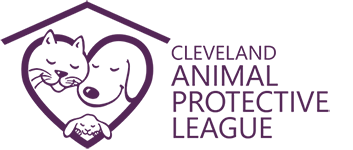![APL_logo_black [Converted]](https://clevelandapl.orgwp-content/uploads/2013/09/APL_logo_black-Converted-300x131.png) Some dogs guard the things that they think are valuable. These can be chews, toys, food, or stolen items like socks or tissues. Your dog may growl, gulp his food, or freeze up when you approach his special items. Guarding behavior ensures survival for canines in the wild. Resources such as food and safe resting places are essential to keep the dog alive so he can reproduce. However, food and resource guarding is not a behavior that we value in our pet dogs.
Some dogs guard the things that they think are valuable. These can be chews, toys, food, or stolen items like socks or tissues. Your dog may growl, gulp his food, or freeze up when you approach his special items. Guarding behavior ensures survival for canines in the wild. Resources such as food and safe resting places are essential to keep the dog alive so he can reproduce. However, food and resource guarding is not a behavior that we value in our pet dogs.
Food guarding behavior can be managed so that everyone remains safe. If children are present in the household, however, it is too risky to have a resource-guarding dog. You must consider the safety of the child when you decide whether to treat the problem or seek other alternatives.
Preventing Food Guarding
If you have a puppy who has not shown any signs of food guarding, you can take measures to prevent resource guarding from developing as your puppy grows into an adult. To start, feed your puppy several meals by hand, giving him his kibble one bite at a time. Pet your puppy with one hand while feeding him from the other hand. Next, hold the bowl in your lap and encourage your puppy to eat from the bowl. As he eats, speak to him softly and pet his head and body. Finally, place the bowl in its usual spot on the floor and periodically drop in a very special treat (hotdogs, cheese, chicken) while your puppy is eating.
Treatment Plan
The signs of aggression that are associated with food guarding include your dog standing stiffly over the bowl, gulping his food, tensing or freezing when you approach his bowl, growling, staring with hard eyes, snapping, biting, chasing people away, or giving whale eye (showing the whites of the eyes).
If you think your dog is at risk for biting, get the help of a behavior professional. It can be dangerous to work with a dog who guards food, and safety is your first priority.
To treat food guarding behavior, follow the seven-step plan below. Move on to the next step when your dog is able to relax for ten meals in a row.
Step One
Start by standing a few feet away from your dog while he eats. Do not move towards the dog. Say, “What have you got there?” and toss a treat towards the bowl. Repeat this every few seconds while your dog eats. Continue to stand three to four feet away from your dog until he relaxes for ten meals in a row, then move on to the next step.
Step Two
Stand a few feet away from your dog’s bowl. Ask, “What have you got there?” and take one step towards the bowl, toss a treat, then step back. Take one step closer each day until you are two feet from the bowl.
Step Three
Stand next to your dog’s bowl and drop in a very special treat (chicken, hotdogs, cheese, beef). Immediately turn around and walk away.
Step Four
Stand next to your dog holding a very special treat in your hand. Bend down slightly and hold the treat out one to two inches towards your dog. Encourage him to stop eating so he can take the treat. As soon as your dog eats the treat, turn around and walk away.
Step Five
Stand next to your dog. Bend down and touch his bowl with one hand while offering a treat with the other hand.
Step Six
Stand next to your dog and pick up his bowl with one hand. Raise the bowl about six inches off the floor and drop in a very special treat. Then, return the bowl to the floor. Repeat this process, raising the bowl a little higher each time. The goal is for you to be able to lift the bowl to waist height while standing upright.
When you are able to raise the bowl to waist height, pick up the bowl and walk with it to the table or counter. Put a very special treat in the bowl, then return it to the floor.
Step Seven
Now it is time for each adult family member to go through the six steps. Your dog may respond well to you picking up his food bowl, but that behavior will not automatically transfer to other members of the household. Do NOT allow children under the age of eighteen to perform these exercises.
This is a gradual program that will teach your dog to relax and anticipate treats while he is eating from his bowl. He will learn to welcome the approach of people because they have special things to offer that are better than his regular kibble.
Do NOT punish your dog for guarding his food or other resources. Trying to “dominate” your dog will most likely make the problem worse, and may put you at risk for being bit. You must understand that, to your dog, food guarding is a natural behavior that he thinks is necessary to his survival. It is important to show your dog that he has nothing to fear with regards to family members taking away his food. So, be patient as you work through these steps.


